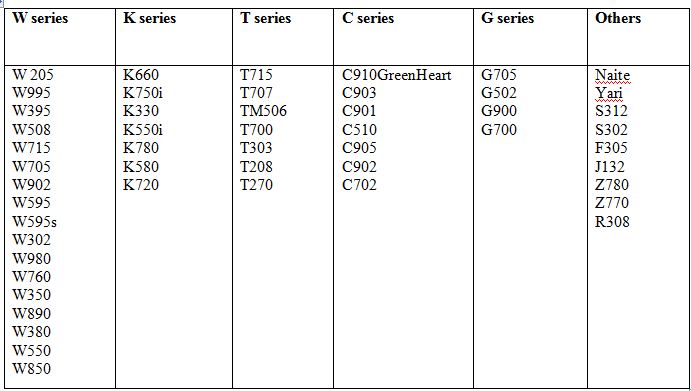Executive summary
Sony Ericsson is one of the top, global, mobile phone manufacturers which serve the worldwide communications market with innovative and feature-rich mobile company.It established on October 1, 2001 by the Japans consumer electronics company Sony Corporation and the Swedish telecommunications company. The company’s global management is based in Harramsmith in London, and it has research & development teams in Sweden, Japan, China, Germany, the United States, India and Pakistan and the United Kingdom. Sony Ericsson already captures their market by providing lot of product and feature. They have effective marketing and management system. They have mission and vision. They are trying to reach goals by providing best products and services. They are effective marketing process and mix also helps them to reach their goals. They have product line and weight, effective marketing promotion and channels, brand name etc.
Introduction
Sony Ericsson is one of the top, global, mobile phone manufacturers which serve the worldwide communications market with innovative and feature-rich mobile company.
Sony Ericsson is joint venture established on October 1, 2001 by the Japans consumer electronics company Sony Corporation and the Swedish telecommunications company Ericsson to make mobile phone. The stated reason for this venture is to combine Sony’s consumer electronics expertise with Ericsson’s technological leadership in the communications sector. Both companies have stopped making their own mobile phones.
The company’s global management is based in Harramsmith in London, and it has research & development teams in Sweden, Japan, China, Germany, the United States, India and Pakistan and the United Kingdom. By 2008, it was the fifth-largest mobile phones manufacturer in the world after Nokia, Samsung and LG and Motorola. The sales of products largely increased due to the launch of the walkman and Cyber-shot series.
Sony and Ericsson are setting up a joint venture to create a new range of mobile devices.The companies got together to combine Ericsson’s telecoms expertise with Sony’s expertise in consumer electronics.
The products created will have neither company’s names on them, instead being marketed under a new brand in a similar fashion to the Play station or Walkman, according to Kurt Hellstrom, chief executive of Ericsson and the new venture’s chairman.
“Mobility and wireless is about to cross the border into all sorts of consumer electronics; Walkman, Game boy, video cameras and so on,” Mr. Hellstrom said.
Sony Ericsson Mobile Communications will be operational from 1 October this year and it will launch its first products during the first half of 2002.
It will have a global work force of 3,500.
But the company will not produce the phones
Combating losses:
The Japanese electronics giant Sony and the Swedish mobile phone company Ericsson joined forces to revitalize their loss making mobile phone operations.
Each of the companies will own 50% of the new venture.
Sony will benefit from the deal because of Ericsson’s customer base and mobile telephony know how.
Ericsson will benefit from links with Sony because its electronics products are seen as innovative, stylish and popular with consumers.
Ericsson mobile communication:
Type Joint Venture
Founder 3october
Headquarters Head office
London, united Kingdom
Incorporated: Sweden
Industry Telecommunications
Products Mobile phone
Mobile Music Devices
Wireless System
Wireless voice devices
Employed 9400 (as the july2008)
Parents Sony Corporation (50%)
Ericsson AB (50%)
Performance:
While Sony Ericsson has been enjoying strong growth recently, its South Korean rival LG Electronices overtook it in 2008 due to the company’s profits falling significantly by 43% to €133 million (approx. US$ 179.6697 million sales falling by 8% and market share dropping from 9.4% to 7.9%, despite favourable conditions that the handset market was expected to grow by 10% in 2008. Sony Ericsson announced another profit warning in June 2008and saw net profit crash by 97% in Q2 2008, announcing that it would cut 2,000 jobs, leading to wide fear that Sony Ericsson is on the verge of decline along with its struggling rival, Motorola In the profits were much on the same level, however November and December saw increased profits along with new models being released such as the C905 being one of the top sellers across the United Kingdom.
Tomorrow challenge:
The competitive arena for telecom operators has changed dramatically over the last few years.
Facing new business challenges, operators need to make the right strategic choices in terms of services offered, how to handle the network evolution and life-cycle management of the network. Ericsson has the knowledge, the ability, and the solutions to work together with operators to form the best market proposition.
Sony Ericsson has benefits:
Ericsson has the knowledge, the ability, and the solutions to work together with operators to form the best market proposition.Ericsson supports the operator’s development and launch of attractive consumer & enterprise propositions and ensures a competitive network strategy by being the operator’s trusted advisor. Ericsson takes a prime integrator role for large and complex network deployment/ transformations projects and by being the operator’s preferred managed services partner, Ericsson manages the solutions throughout the entire life-cycle.
- Innovative consumer and business-user services solutions to drive revenue growth
- Optimized network operations solutions to enable reduced operational cost
- Efficient network transformation solutions to ensure qualitative service delivery and full network support for the operator’s business strategy.
Ericsson’s capabilities together with our solutions provide the best support an operator can get in building long-term sustainable business growth strategies market.
Sony Ericsson commitment winning product combination:
Ericsson’s extensive experience of the telecoms arena, a firm commitment to research and development, a unique understanding of customer needs and a leading role in creating industry-wide standards, has led to an extensive portfolio of products to address both technology and customer demands.
Core Network:
Ericsson’s market-leading Core Network provides efficient deployment and management of user services while supporting fast and reliable migration to converged, IP-based soft switch and IMS networks.
Cable interconnect product:
Ericsson has utilized its vast experience in technology, product development and production of cables and passive network materials to develop a broad offering of Cables & interconnect products.
Licenses program:
Patents help facilitate the voluntary sharing of knowledge and technology. In exchange for sharing and enabling the enhancement of technological development, patent owners are awarded a limited period of reserved rights to ensure adequate remuneration. In contrast to industries in which patents are primarily used to exclude competitors from a market, patents play an active role in developing the telecommunications industry through standardization and licensing.
It is Ericsson’s philosophy that licenses for patents essential to standards should be widely available at fair, reasonable and non-discriminatory (FRAND) terms, subject to reciprocity, to provide compensation to companies that have made substantial investments in the development of these standards. Our licensing terms for patents essential to a specific standard comply with the prevalent industry interpretation of FRAND, i.e. the basis is a reasonable maximum aggregate royalty rate to which each patent holder is entitled a proportion according to its relative share of all standard essential IPR. Ericsson has successfully made its essential patent portfolios widely available at FRAND terms.
Ericsson´s FRAND licensing programs are based on bilateral negotiations in which the potential licensee is presented with detailed analyses (“claim charts”) from our large portfolio of essential patents, and given the opportunity to challenge the essentiality and validity of these. Based on feedback received through a large number of such negotiations, it is universally acknowledged that Ericsson´s owns the strongest GSM and WCDMA patent portfolios in the industry, second to none. We are confident that the same will be true for standards beyond 3G. For example, for the upcoming 3GPP Long Term Evolution (LTE) standard, Ericsson expects to hold a relative patent strength of 20-25% of all standard essential IPR. Ericsson believes the market will drive all players to act in accordance with these principles and to a reasonable maximum aggregate royalty level of 6-8% for handsets. Ericsson´s fair royalty rate for LTE is therefore expected to be around 1.5% for handsets.
Corporate responsibility:
The Millennium Development Goals aim to reduce extreme poverty and hunger by half, improving education, health, gender equality and environmental sustainability by 2015. Ericsson supports social and economic development through telecommunications and its commitment to human right.
Sony Ericsson developed by developers:
Sony Ericsson Developer World is a global support program and web portal totally dedicated to helping serious, wireless developers achieve business success by providing the documentation, tools, training, technical and go-to-market support you need in your development process.
The developer World helps professional developers get on the fast track from mind to market.
This ensures that a constant stream of fun, useful and innovative content and applications is continually available for Sony Ericsson mobile phones operating.
Sony Ericsson product mobile phone Line:

Highlights (January 16, 2008)
Sony Ericsson sells over 100 million handsets in 2007:
The consolidated financial summary for Sony Ericsson Mobile Communications AB (Sony Ericsson) for the fourth quarter ended December 31, 2007 is as follows:
- 18% increase in volume year-on-year
- Continued market share gains and profitable growth
- Continued investment for the future
2007 Highlights:
- Over 100 million units sold – more than double global market growth rate
- Margins remain strong as company shifts to broader portfolio
- Unit growth underpinned by increased sales of lower priced phones
- 145 million music enabled phones sold to date, of which 57 million were
- Walkman® phones – maintaining leadership in music.
Sony Ericsson gained market share during the quarter due to the continued success of such products as the K550 Cyber-shot(TM) and the W200, W300 and W580 Walkman® phones in the Americas and Europe. Although Average Selling Price (ASP) increased slightly sequentially during the quarter, as a result of the introduction of new flag-ship Walkman® and Cyber-shot(TM) phones such as the W910 and K850 models, the trend for falling ASPs year-on-year reflects the company’s direction to broaden its product portfolio.
Sony Ericsson finished a very good year, which highlighted how the company has strategically positioned itself to capture market share with an expanded product portfolio. Investments are being made in both R&D and brand building, to deepen the portfolio and strengthen Sony Ericsson’s presence in new and developing markets around the world. Our target remains to become one of the top three players in the industry, and the momentum we established in 2006 and 2007 makes this a realistic and achievable ambition,” said Dick Komiyama, President of Sony Ericsson.
Sony Ericsson estimates the 2007 global handset market as being over 1.1 billion units, in line with previous forecasts. On this basis the company believes it grew market shares around 2 percentage points to reach slightly over 9% for the full year 2007 compared to full year 2006.
Sony Ericsson company market business report:
Company Profile will assists individual investors, managers and companies in evaluating opportunities, trends, market innovations, and selecting appropriate information solutions in order to make effective decisions. The report has been made after extensive research using the data available from reliable publications, trade associations and the companies’ sources. The report elaborates on the company’s business structure and operations, products and services. The report include strategic analysis that intends to aid investors to find better prospects with the company and gain an insight into the corporate policies.
Report Highlights :
– Provides a snapshot version of the company’s performance.
– It offers key company data and analysis vis-à-vis to the major industry players. This information is vital from the point of estimating business strategies of the company and facilitate in decision-making process for the investors.
– Tracks major M&A trends and developments undertaken in the current fiscal year to get a better understanding of company’s growth strategies.
– The report identifies and analyzes the company’s strength and weaknesses to come up with the possible opportunities for the company.
– The report comments on the company’s outlook for the forthcoming periods on the strategic point of views.
– Supplemented with graphs and tabular information on the key industry players, overall financial and market performances, list of products and services, and company’s share performances.
Social and Environmental Performance Highlights 2006:
Ericsson and Sony Ericsson work closely within the area of corporate responsibility, together covering the full value chain for mobile networks and sharing a common vision of sustainability. In 2006, Sony Ericsson continued to phase out harmful environmental substances from its products and stepped up its commitment to monitor its supply chain.
Sony Ericsson, a 50/50 joint venture of Sony Corporation and Ericsson, was established in 2001 and is a provider of mobile multimedia devices, including mobile phones, accessories and PC cards. The company employs approximately 7,500 people worldwide. In 2006, volume and sales grew to 74.8 million units and EUR 10,959 million respectively.
There is a growing demand among customers for environmentally adapted products and services. To meet and exceed market expectations, Sony Ericsson aims to deliver solutions that help to reduce global resource consumption and emissions to air, land and water. The company has a Corporate Responsibility Code that applies to all Sony Ericsson operations as well as a Social Responsibility Code for its suppliers.
Sony Ericsson was the first in the mobile handset industry to phase out all brominates flame-retardants. Therefore it was well prepared to meet the requirements of the European Union legislation the Restriction of the Use of Certain Hazardous Substances Directive (RoHS), which took effect July, 2006. In 2006, all Sony Ericsson products manufactured were RoHS-compliant.
Brominates flame-retardants are important to eliminate, as they are persistent and bio-accumulative and can be hazardous to those recycling discarded phones.
Sony Ericsson made progress in 2006 towards eliminating polyvinyl chloride (PVC) in all its products, and as of 2007, all new phones and accessories will be PVC-free
Phasing out hazardous substances:
Sony Ericsson was the first mobile phone manufacturer with low-energy phone chargers and energy consumption continues to be a priority. It is working to reduce the amount of raw materials and components, since they consume most energy in phone manufacture.
The energy intensity of mobile phone manufacturing should also be seen in light of the increased functionality of advanced phones, which reduce the need for a user to have other electronic devices. An updated assessment of mobile phone manufacturing will be included in Ericsson’s updated mobile system Life Cycle Assessment (LCA), scheduled for 2007.
Recycling
Sony Ericsson is participating in existing voluntary and required collection and recycling schemes in many countries around the world. It also works together with international organizations such as the UN Environment Programmed to set up guidelines for proper management of products for recycling and reuse.
Supply chain
In 2006, Sony Ericsson audited 20 percent of its supply chain in regards to the Supplier Social Responsibility Code. This included all major suppliers in Asia, considered a high-risk region for meeting social responsibility standards. The Code places expectations on suppliers to provide a safe workplace for employees, respect basic human rights, and apply proper ethical standards in all business dealings.
Sony Ericsson engages with suppliers to raise standards, so that they understand the importance of the Code and recognize it as a competitive advantage and part of their responsibility as an employer. In cases where there is insufficient willingness to make improvements, Sony Ericsson will take steps to end the relationship. In 2006, two potential suppliers were disqualified because they could not meet the Code. In 2006, Sony Ericsson and Ericsson cooperated in areas of supply chain management, the formation of a common auditors network, LCA, research and design. These types of partnerships in the value chain help both companies adopt a more holistic and all-encompassing approach to addressing the sector’s social and environmental impact.
Leadership through Total Supply Chain Transformation:
Few transformations have been as fast and complete as the one at cell phone maker Sony Ericsson. Here are some of the milestones that matter:
2002—Sony Ericsson reports a before-tax net loss of Euro 291M on Euro 4.2B in sales. The company bleeds cash and registers the worst service in its industry. 2006—Sony Ericsson delivers Euro 1.3B pre-tax profit on Euro 11B in sales, among the highest operating margins in the business.
- Last six months of 2007—Vodafone, the company’s largest customer, notes Sony Ericsson has consistently been among its top-two vendors on service performance.
Product development:
Sony Ericsson use the latest design, analysis and experimental tools and methods to accurately model product and process performance, determine reliability, and to predict failures before they occur. We specialize in helping consumer products manufacturers improve profitability by dramatically reducing development time, eliminating trial and error rework, compressing process cycle times, rapidly resolving problems in the trade, and reducing risks associated with product liability.
Sony Ericsson Company Product services include:
Product Design
Failure Analysis
Process Simulation
Reliability Engineering
Process Technology
Legal Support
Testing
Injection Molding
Fluid Mechanics
Material Science
Sony ericsson objective is making your product a commercial success. We define success as a product reaching its target market on time at the right price point delivering quality consistent with market needs and performance consistent with market demands. We achieve success by focusing on five key issues: (1) understanding and responding to your market, (2) understanding and responding to your business situation, (3) managing risks throughout the project, (4) managing unit manufactured costs throughout the project, and (5) following a defined, managed development process.
Product failure:
Sony ericsson services to uses the latest design, analysis and experimental tools to model performance and predict failures before they happen. We also offer a full range of electrical molding services. In addition to avoiding costly failures, the benefits of a turn-key approach include:
●Reduced Design Iteration and Downstream Rework.
Reduced Product Liability.
Product life cycle:
The product life cycle is the course that company sales and profits take over the company lifetime. Product life cycle goes through many phases involves many professional disciplines, and requires many skills, tools and processes. Product life cycle (PLC) has to do with the life of a product in the market with respect to business and commercial costs and sales measures of Sony Ericsson. To say that a product has a life cycle is to assert four things: 1) that products have a limited life, 2) product sales pass through distinct stages, each posing different challenges, opportunities, and problems to the seller, 3) profits rise and fall at different stages of product life cycle, and 4) products require different marketing, financial, manufacturing, purchasing, and human resource strategies in each life cycle stage.
Market introduction stage:
Introduction stage is when the product is first distributed and made available to purchases of Sony Ericsson.
I. Mobile phone costs are high
II. Slow sales volumes to start
III. Little or no competition – competitive manufacturers watch for acceptance/segment growth losses
IV. Demand has to be created
V. Customers has to be prompted to try the product
VI. Makes no money at this stage
Growth stage:
The consumer is satisfies the new market product.
I. Costs reduced due to economies of scale
II .Sales volume increases significantly
III. Profitability begins to rise
IV .Public awareness increases
V. Competition begins to increase with a few new players in establishing market
VI. Increased competition leads to price decreases.
Maturity stage:
The stages are a long lasting of product that consumer acceptance.
I.Costs are lowered as a result of production volumes increasing and experience curve effects
II. Sales volume peaks and market saturation is reached
III. Increase in competitors entering the market
IV. Prices tend to drop due to the proliferation of competing products
V. Brand differentiation and feature diversification is emphasized to maintain or increase market share
VI. Industrial profits go down
Decline stage:
The product sales are decline and extended time for creating a weak product.
I. Costs become counter-optimal.
II. Sales volume decline or stabilize.
III. Prices, profitability diminish.
IV. Profit becomes more a challenge of production/distribution efficiency than increased sales.
Marketing Mix:
Product:
Sony Ericsson has lot of mobile phone product. They have lot of product line.
Price:
Sony Ericsson’s different product has different price.
Place:
Sony Ericsson provides their product all over the world.
Promotion:
Sony Ericsson has a huge market that’s why they provide almost all kinds of promotion to capture their market.
| Product | Price | Place | Promotion |
| Sony Ericsson J120i Cell Phone |
CODE: EM103
$48.42All over the worldAll kind of promotionSony Ericsson Z320i Cell Phone
CODE: EM103
$74.65All over the worldAll kind of promotionSONY ERICSSON W910
$236.99All over the worldAll kind of promotionSony Ericsson w59 $312.99All over the worldAll kind of promotion
Marketing is an integrated communications-based process through which individuals and communities discover that existing and newly-identified needs and wants may be satisfied by the products and services of others.
Advertising is the promotion of a product or service and is extremely pervasive in contemporary society. To maximize sales, companies will pay a premium for wide exposure through the mass media. Advertising space is common, but not restricted to these realms; billboards, public transportation, movies (product placement), schools, clothing, even bathroom stalls carry ads and the industry are constantly finding new ways to advertise.
The United States has the largest advertising market, accounting for half of the world’s advertising expenditures (estimated at 500 billion in 2004 by the New Yorker). Japan holds a secure second place over Germany and the United Kingdom but still at less than one fifth of the U.S.
Advertising is a form of communication used to help sell products and services. Typically it communicates a message including the name of the product or service and how that product or service could potentially benefit the consumer. However, Advertising does typically attempt to persuade potential customers to purchaser to consume more of a particular brand of product or service. Modern advertising developed with the rise of mass production in the late 19th and early 20th centuries.
Many advertisements are designed to generate increased consumption of those products and services through the creation and reinvention of the “brand image”. For these purposes, advertisements sometimes embed their persuasive message with factual information. There are many media used to deliver these messages, including traditional media such as television, radio, cinema, magazines, newspapers, video games, the bags, billboard, mail or post and Internet. Today, new media such as digital signage is growing as a major new mass media. Advertising is often placed by an advertising agency on behalf of a company or other organization.
Organizations that frequently spend large sums of money on advertising that sells what is not, strictly speaking, a product or service include political parties, interest groups, religious organizations, and military recruiters. Non-profit organizations are not typical advertising clients, and may rely on free modes of persuasion, such as public service announcement
Money spent on advertising has increased dramatically in recent years. In 2007, spending on advertising has been estimated at over $150 billion in the United Statesand $385 billion worldwide and the latter to exceed $450 billion by 2010.
Informative advertisement:
The customer is introducing a new product such as MobileVB V3.5 – Sony Ericsson P800 Support.
MobileVB already supports Visual Basic development for the Nokia Series 80 interface on the Nokia 9210 and Nokia 9290 smart phones, along with its long standing support of Palm and Pocket PC devices. Released on Friday 14 March the latest version of MobileVB, version 3.5, adds support for the Sony Ericsson P800 which opens the first Symbian OS phone to compete with the popular palmtop PDA market to Visual Basic developers.
Persuasive advertising: This is important with high competition to build demand with other brand .( modelsP 900) This models user interface, Ring-Writer, for pen-on-touch screen based mobile devices evolves mobile text entry beyond thumbing on numeric keypads and miniaturized keyboards.
Sale promotion:
Sony Ericsson is running a digital campaign linked to its association with the new James Bond film, turning people’s phones into spy-like gadgets and giving them a chance to live like 2007.
Created by Iris Digital, the campaign is part of the company’s integrated marketing push which highlights the features of the C902 Titanium Silver Cyber-shot phone used by James Bond in Quantum of Solace, released today (October 31).
A rich-content micro site www.sonyericsson.com/bond hosts “Directive C902”, an interactive movie that puts a player’s secret agent skills to the test across four missions, while showcasing the phone’s features and functions.
Filmed in the style of a spy thriller, each successfully completed mission delivers a code that unlocks an exclusive mobile phone application and grants access to the next level of the game.
Upon completing the four tiers of the game, players are invited to enter a competition to win a VIP trip to Monte Carlo and experience the Bond lifestyle firsthand. The website also plays host to the Quantum of Solace trailer and further information on Sony Ericsson phones.
Among the Bond-themed mobile applications available to download is a “wireless spy cam”, which turns a player’s camera phone into a fully working gadget. Users can set up their phone to take photos at regular intervals for a set period of time and automatically email the captured shots to their inbox.
Other mobile downloads include a fingerprint scanner, an x-ray viewer and a universal detector, all designed to trick unwary friends and colleagues into believing the phone has come straight from Q’s research and development lab.
Communication is a process of transferring information from one entity to another. Communication processes are sign-mediated interactions between at least two agents which share a repertoire of signs and semiotic rules.
“Customer service is a series of activities designed to enhance the level of customer satisfaction – that is, the feeling that a product or service has met the customer expectation.”
Its importance varies by product, industry and customer; defective or broken merchandise can be exchanged, often only with a receipt and within a specified time frame. Retail stores will often have a desk or counter devoted to dealing with returns, exchanges and complaints, or will perform related functions at the point of sale.
Sales process engineering has been described as “the systematic application of scientific and mathematical principles to achieve the practical goals of a particular sales process” Selden pointed out that in this context, sales referred to the output of a process involving a variety of functions across an organization, and not that of a “sales department” alone. Primary areas of application span functions including sales, marketing, and customer service. Variations of this brief description are possible, but described as such, the discipline is consistent with other published definitions of engineering and its many well-established branches, but relatively new in its focus.
Branding: A product identity, or brand image are typically the attributes one associates with a brand, how the brand owner wants the consumer to perceive the brand – and by extension the branded company, organization, product or service. The brand owner will seek to bridge the gap between the brand image and the brand identity. Effective brand names build a connection between the brand personalities as it is perceived by the target audience and the actual product/service. The brand name should be conceptually on target with the product/service (what the company stands for)./
A sale is the pinnacle activity involved in selling products or services in return for money or other compensation. It is an act of completion of a commercial activity.
A sale is completed by the seller, the owner of the goods. It starts with consent (or agreement) to an acquisition or appropriation or request followed by the passing of title (property or ownership) in the item and the application and due settlement of a price, the obligation for which arises due to the seller’s requirement to pass ownership, being a price the seller is happy to part with ownership of or any claim upon the item. The purchaser, though a party to the sale, does not execute the sale, only the seller does that. To be precise the sale completes prior to the payment and gives rise to the obligation of payment. If the seller completes the first two above stages (consent and passing ownership) of the sale prior to settlement of the price the sale is still valid and gives rise to an obligation to pay.
Selling is thought of as a part of marketing, however, the two disciplines are completely different. Sales often form a separate grouping in a corporate structure, employing separate specialist operatives known as sales people .Selling is considered by many to be a sort of persuading “art.
Sale promotion:
Sony Ericsson is running a digital campaign linked to its association with the new James Bond film, turning people’s phones into spy-like gadgets and giving them a chance to live like 2007.
Created by Iris Digital, the campaign is part of the company’s integrated marketing push which highlights the features of the C902 Titanium Silver Cyber-shot phone used by James Bond in Quantum of Solace, released today (October 31).
A rich-content micro site www.sonyericsson.com/bond hosts “Directive C902”, an interactive movie that puts a player’s secret agent skills to the test across four missions, while showcasing the phone’s features and functions.
Filmed in the style of a spy thriller, each successfully completed mission delivers a code that unlocks an exclusive mobile phone application and grants access to the next level of the game.
Upon completing the four tiers of the game, players are invited to enter a competition to win a VIP trip to Monte Carlo and experience the Bond lifestyle firsthand. The website also plays host to the Quantum of Solace trailer and further information on Sony Ericsson phones.
Among the Bond-themed mobile applications available to download is a “wireless spy cam”, which turns a player’s camera phone into a fully working gadget. Users can set up their phone to take photos at regular intervals for a set period of time and automatically email the captured shots to their inbox.
Other mobile downloads include a fingerprint scanner, an x-ray viewer and a universal detector, all designed to trick unwary friends and colleagues into believing the phone has come straight from Q’s research and development lab.
Total: $287.87
“LIST PRICE” is the suggested retail price provided to us by our suppliers. We make no representation that a substantial number of these products have been sold or offered for sale at the list price. Actual retail prices in your area may be substantially different. Because we sell our merchandise over the internet on a national basis, it is not possible to know if our merchandise is sold at list price in any particular location or at any particular time. “YOU SAVE” reflects the difference between our price and the supplier provided list price shown on our sites. Because the list price may be different than the actual retail prices in your area, you may not actually realize a savings of this amount and may want to make an exact comparison for yourself by checking the prices of other internet or local retailers prior to making a purchase.
Recommendations:
Sony Ericsson is one of the top, global, mobile phone manufacturers but they have lot of competitor in the market. They face more competition in market. Their close competitors are Nokia, LG, Samsung, Motorola etc. these companies has large market share. Sony Ericsson more focuses on higher level customer. Though now they are focusing on middle or low level customer but the focus is not enough. Though developing country has a large market but they don’t focus on those countries. Their product is relatively expensive than other product. So their marketing and management people need to more focus on these problems. They should provide their product more cheaper rate.
Limitation of the report:
- Time is very short to cover the entire term paper.
- Information is not available.
- Difficult to organize the whole term paper.
References:
1) (Retrieved July 16, 2009).
From http://www.myshopping .com
2) (Retrieved July 20, 2009). From
http://www.sonyericsson.com
3) (Retrieved July 20, 2009)
From http://www.google.com.bd/images
4) (Retrieved July 22, 2009)
From www.blogcdn.com
5). (Retrieved July 25, 2009).
From http://www.engadget.com
















